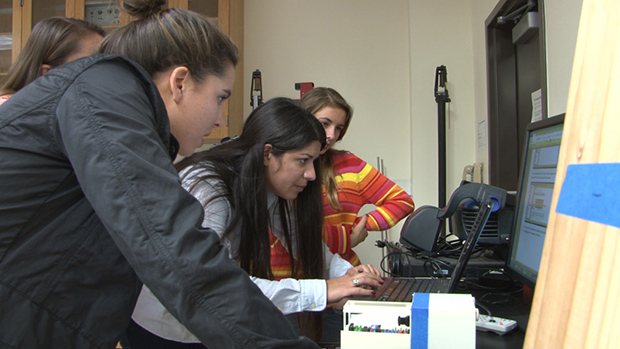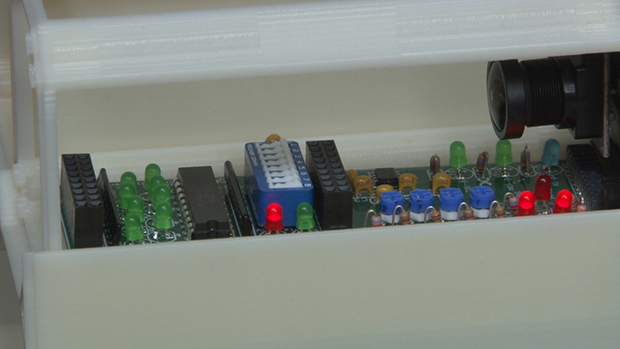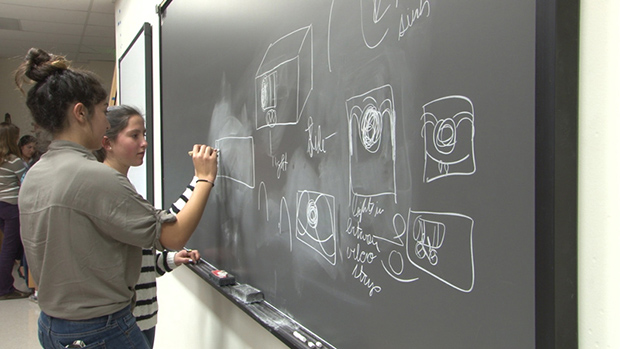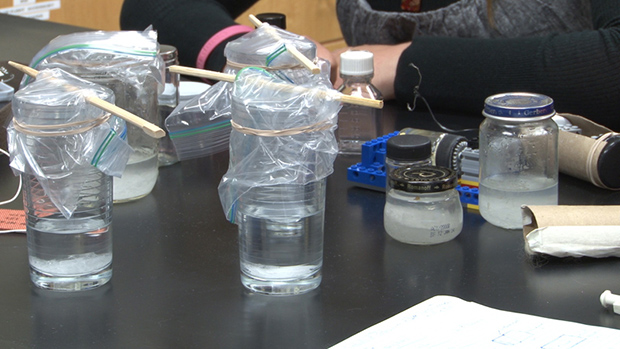
California High School Girls Build Experiment for Space Station
By:
- Doug Ramsey
Published Date
By:
- Doug Ramsey
Share This:
Article Content

Calit2 researcher Saura Naderi (center) works with girls from the BE WiSE program.
Fifteen girls from high schools around San Diego County have been meeting once a week since September to conceive, design, engineer and program a micro-experiment set to be deployed on the International Space Station (ISS) in March 2013. They are building a crystal growth experiment for a microgravity environment.
A partnership of San Diego County industry, non-governmental organizations, schools and research institutes has provided funding and other support to make the program a reality, and the consortium formally will announce the partnership at a news conference December 4 on the UC San Diego campus at the headquarters of the California Institute for Telecommunications and Information Technology (Calit2), a supporting sponsor.

Nanolab crystal growth experiment to be deployed on the International Space Station
All of the girls participating in the project are members of Better Education for Women in Science and Engineering (BE WiSE), a program of the San Diego Science Alliance (SDSA), an important catalyst of Science, Technology, Engineering and Math (STEM) learning for K-12 students in San Diego County. “As part of our mission, SDSA strives to build bridges between business, education and scientific research communities to ignite STEM learning. We are extremely excited to be a part of this collaborative voyage into space.” said SDSA Executive Director Nancy Taylor.
BE WiSE member students entering 9th, 10th or 11th grade in fall 2012 were eligible to apply to be on the ISS team, and they are mentored by teachers, industry volunteers and BE WiSE alumni.
“BE WiSE provides opportunities for girls to interact with women who are professionals in the field,” said the program’s co-founder, Patricia S. Winter. “Fortunately, this thrilling opportunity was introduced to BE WiSE from The Quest Institute for Quality Education in partnership with the Applied Math Science and Engineering Institute of Valley Christian Schools in San Jose, California, where they are working for the third year in a row to send experiments to the International Space Station.”
The San Diego experiment is one of eight student-designed devices to be deployed in a so-called NanoLab aboard the ISS. The experiment will spend one month in orbit traveling approximately 15 million miles at an altitude of about 250 miles above the Earth. The dimensions of the capsule are just 2 inches by 2 inches by 4 inches.

High school students work on schematic of experiment.
“They have to solve the problems of creating a micro experiment that must fit and perform in a very confined environment,” said Shari Duran, a subject area specialist at Steele Canyon Charter High School, one of 13 San Diego area high schools participating in the project. “The energy, excitement and teamwork the girls generate as they apply their science and math knowledge is truly inspiring.”
All team members independently completed a programming and circuit-board project before the team began to meet in September.
As designed by the team, the crystal growth experiment will analyze the crystalline structure of alum, the common name for potassium aluminum sulfate dodecahydrate – the chemical compound KAl(SO4)2 -- which is used in products ranging from deodorant to water purification systems. The girls will have a control experiment on Earth with which they will perform the identical test to see if the results vary due to the influence of microgravity.
Each of the 15 girls has assumed the real tasks of a research or payload scientist, programmer, or engineer in creating the experiment. “They are learning how to work as a team even though they come from different schools,” said Lara Dickens, a BE WiSE mentor and science teacher at Patrick Henry High School. “They are working against a tight deadline, so they are also learning how to communicate between and among each sub-group to accomplish tasks under demanding time and space constraints.”
In October, Realcomm Conference Group, LLC, announced that it was co-sponsoring the BE WiSE project to build a micro-experiment destined for space. “Given that the ISS is the ‘most intelligent building in the universe,’ this fits very well with the mission and vision of Realcomm,” said company founder and Chief Executive Officer, Jim Young, noting that the company is a global leader in technologies for the real estate industry. “Realcomm has been working for many years to raise money and awareness that would bring accelerated math and science education into the mainstream conversation. Sponsoring 15 young women from the BE WiSE program to install a micro-lab experiment on the ISS was an excellent opportunity that could not be missed.”

Doing benchmark tests on land to compare with microgravity results
Realcomm encouraged Calit2 to become a supporting sponsor of the project. “We are very much about working with industry and non-profit groups to provide hands-on research experiences that engage students from interdisciplinary backgrounds,” said Larry Smarr, director of Calit2, a partnership of UC San Diego and UC Irvine. “Calit2’s MyLab program led by Saura Naderi at UCSD gets undergraduate engineering volunteers to work closely with young girls from underserved K-12 schools, so helping the girls get their ISS experiment ‘off the ground’ was a natural fit.”
Calit2 and Realcomm are hoping that the ISS project can be a catalyst for San Diego businesses to become more involved in the advancement of active STEM learning in local schools.
Schools represented by the students on the BE WiSE space station project include: Academy of our Lady of Peace; Canyon Crest Academy; Carlsbad High School; Cathedral Catholic High School; La Jolla High School; Mission Vista High School; Patrick Henry High School; Rancho Buena Vista High School; San Diego High School of International Studies; San Marcos High School; Santa Fe Christian Schools; The Bishop's School; and Torrey Pines High School.
The experiment will be deployed to NASA’s U.S. National Lab aboard the International Space Station, and made possible by NanoRacks, LLC, via its Space Act Agreement with NASA. The company’s facilities two NanoLab Platforms, a NanoRacks Plate Reader, NanoRacks Microscope and NanoRacks MixStix, all of which provide repeatable microgravity research opportunities on the ISS. NanoRacks recently had its busiest quarter yet, after sending up 25 payloads about the SpaceX, the first commercial space vehicle to dock with the International Space Station.
Share This:
You May Also Like
Stay in the Know
Keep up with all the latest from UC San Diego. Subscribe to the newsletter today.


